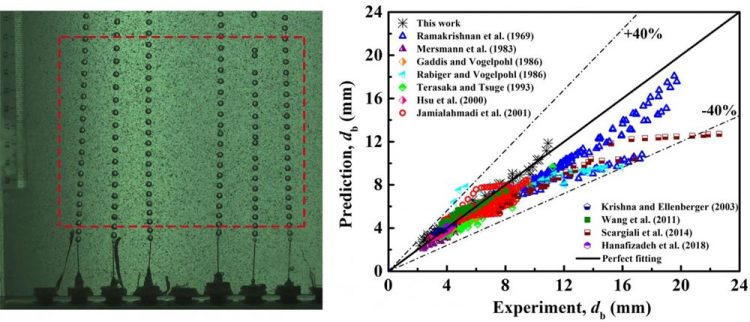Scientists develop bubble diameter prediction model for industrial use

(a) Typical bubble formation image; (b) Rational validation of the proposed prediction correlation. Credit: HUANG Qingshan
Accurate prediction of bubble diameter is crucial for the proper design, optimization, and scale-up of gas-liquid apparatuses. Most previous research focused only on orifice superficial gas velocity < 10 m/s, which is too low for industrial gas-liquid reactors.
Recently, a research team led by Prof. YANG Chao from the Qingdao Institute of Bioenergy and Bioprocess Technology (QIBEBT), Chinese Academy of Sciences (CAS), systematically investigated the influence of orifice diameter, liquid viscosity, surface tension and orifice superficial gas velocity on the bubble diameter of gas spargers under industrial jetting conditions.
In the study, the bubble diameter was investigated in a rectangular vessel made of transparent Plexiglas.
Bubbles were recorded through a single-lens reflex camera. A typical bubble formation image is illustrated in Fig.1 (a). Bubble sizes were analyzed and calculated using patented software (Chinese Software Copyright Registration Number: 2017SR354522).
Based on extensive experimental results, a simple correlation for predicting bubble diameter was proposed using nonlinear least square optimization. The new correlation was successfully validated by comparing prediction results with experimental data over a wide range of operating conditions and working systems from the literature.
The comparison of the results predicted by the new model versus the experimental data from our work and the literature is shown in Fig. 1 (b).
Only 6.54% of the 657 experimental results obtained from the literature had deviations of more than 30%, indicating that the proposed correlation in this work can be applied extensively with reasonable accuracy.
These findings were published in Chemical Engineering Science. This work was supported by the National Natural Science Foundation of China, the Instrument Developing Project of CAS, and the “Transformational Technologies for Clean Energy and Demonstration”, Strategic Priority Research Program of CAS.
Media Contact
More Information:
http://dx.doi.org/10.1016/j.ces.2019.02.009All latest news from the category: Life Sciences and Chemistry
Articles and reports from the Life Sciences and chemistry area deal with applied and basic research into modern biology, chemistry and human medicine.
Valuable information can be found on a range of life sciences fields including bacteriology, biochemistry, bionics, bioinformatics, biophysics, biotechnology, genetics, geobotany, human biology, marine biology, microbiology, molecular biology, cellular biology, zoology, bioinorganic chemistry, microchemistry and environmental chemistry.
Newest articles

Bringing bio-inspired robots to life
Nebraska researcher Eric Markvicka gets NSF CAREER Award to pursue manufacture of novel materials for soft robotics and stretchable electronics. Engineers are increasingly eager to develop robots that mimic the…

Bella moths use poison to attract mates
Scientists are closer to finding out how. Pyrrolizidine alkaloids are as bitter and toxic as they are hard to pronounce. They’re produced by several different types of plants and are…

AI tool creates ‘synthetic’ images of cells
…for enhanced microscopy analysis. Observing individual cells through microscopes can reveal a range of important cell biological phenomena that frequently play a role in human diseases, but the process of…





















